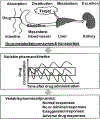ABC transporters in multidrug resistance and pharmacokinetics, and strategies for drug development
- PMID: 23688078
- PMCID: PMC6341993
- DOI: 10.2174/138161282005140214165212
ABC transporters in multidrug resistance and pharmacokinetics, and strategies for drug development
Abstract
Multidrug resistance (MDR) is a serious problem that hampers the success of cancer pharmacotherapy. A common mechanism is the overexpression of ATP-binding cassette (ABC) efflux transporters in cancer cells such as P-glycoprotein (P-gp/ABCB1), multidrug resistance-associated protein 1 (MRP1/ABCC1) and breast cancer resistance protein (BCRP/ABCG2) that limit the exposure to anticancer drugs. One way to overcome MDR is to develop ABC efflux transporter inhibitors to sensitize cancer cells to chemotherapeutic drugs. The complete clinical trials thus far have showen that those tested chemosensitizers only add limited or no benefits to cancer patients. Some MDR modulators are merely toxic, and others induce unwanted drug-drug interactions. Actually, many ABC transporters are also expressed abundantly in the gastrointestinal tract, liver, kidney, brain and other normal tissues, and they largely determine drug absorption, distribution and excretion, and affect the overall pharmacokinetic properties of drugs in humans. In addition, ABC transporters such as P-gp, MRP1 and BCRP co-expressed in tumors show a broad and overlapped specificity for substrates and MDR modulators. Thus reliable preclinical assays and models are required for the assessment of transporter-mediated flux and potential effects on pharmacokinetics in drug development. In this review, we provide an overview of the role of ABC efflux transporters in MDR and pharmacokinetics. Preclinical assays for the assessment of drug transport and development of MDR modulators are also discussed.
Conflict of interest statement
CONFLICT OF INTEREST
The authors confirm that this article content has no conflicts of interest.
Figures



Similar articles
-
Mammalian drug efflux transporters of the ATP binding cassette (ABC) family in multidrug resistance: A review of the past decade.Cancer Lett. 2016 Jan 1;370(1):153-64. doi: 10.1016/j.canlet.2015.10.010. Epub 2015 Oct 20. Cancer Lett. 2016. PMID: 26499806 Review.
-
β-carotene reverses multidrug resistant cancer cells by selectively modulating human P-glycoprotein function.Phytomedicine. 2016 Mar 15;23(3):316-23. doi: 10.1016/j.phymed.2016.01.008. Epub 2016 Feb 6. Phytomedicine. 2016. PMID: 26969385
-
Modulation of function of three ABC drug transporters, P-glycoprotein (ABCB1), mitoxantrone resistance protein (ABCG2) and multidrug resistance protein 1 (ABCC1) by tetrahydrocurcumin, a major metabolite of curcumin.Mol Cell Biochem. 2007 Feb;296(1-2):85-95. doi: 10.1007/s11010-006-9302-8. Epub 2006 Sep 8. Mol Cell Biochem. 2007. PMID: 16960658
-
Dacomitinib antagonizes multidrug resistance (MDR) in cancer cells by inhibiting the efflux activity of ABCB1 and ABCG2 transporters.Cancer Lett. 2018 May 1;421:186-198. doi: 10.1016/j.canlet.2018.01.021. Epub 2018 Jan 11. Cancer Lett. 2018. PMID: 29331420
-
ATP-binding cassette efflux transporters and MDR in cancer.Drug Discov Today. 2023 May;28(5):103537. doi: 10.1016/j.drudis.2023.103537. Epub 2023 Feb 16. Drug Discov Today. 2023. PMID: 36801375 Review.
Cited by
-
Exploring MicroRNA and Exosome Involvement in Malignant Pleural Mesothelioma Drug Response.Cancers (Basel). 2022 Sep 30;14(19):4784. doi: 10.3390/cancers14194784. Cancers (Basel). 2022. PMID: 36230710 Free PMC article.
-
Molecular design, synthesis and biological evaluation of novel 1,2,5-trisubstituted benzimidazole derivatives as cytotoxic agents endowed with ABCB1 inhibitory action to overcome multidrug resistance in cancer cells.J Enzyme Inhib Med Chem. 2022 Dec;37(1):2710-2724. doi: 10.1080/14756366.2022.2127700. J Enzyme Inhib Med Chem. 2022. PMID: 36168121 Free PMC article.
-
Mechanisms of Melanoma Progression and Treatment Resistance: Role of Cancer Stem-like Cells.Cancers (Basel). 2024 Jan 22;16(2):470. doi: 10.3390/cancers16020470. Cancers (Basel). 2024. PMID: 38275910 Free PMC article. Review.
-
Advances in siRNA Drug Delivery Strategies for Targeted TNBC Therapy.Bioengineering (Basel). 2024 Aug 14;11(8):830. doi: 10.3390/bioengineering11080830. Bioengineering (Basel). 2024. PMID: 39199788 Free PMC article. Review.
-
Nodal is involved in chemoresistance of renal cell carcinoma cells via regulation of ABCB1.J Cancer. 2021 Feb 2;12(7):2041-2049. doi: 10.7150/jca.52092. eCollection 2021. J Cancer. 2021. PMID: 33754002 Free PMC article.
References
-
- Higgins CF. Multiple molecular mechanisms for multidrug resistance transporters. Nature 2007; 446: 749–57. - PubMed
-
- Krishna R, Mayer LD. Multidrug resistance (MDR) in cancer. Mechanisms, reversal using modulators of MDR and the role of MDR modulators in influencing the pharmacokinetics of anticancer drugs. Eur J Pharm Sci 2000; 1 1: 265–83. - PubMed
-
- Calcagno AM, Kim IW, Wu CP, Shukla S, Ambudkar SV. ABC drug transporters as molecular targets for the prevention of multidrug resistance and drug-drug interactions. Current drug delivery 2007; 4: 324–33. - PubMed
-
- Szakacs G, Paterson JK, Ludwig JA, Booth-Genthe C, Gottesman MM. Targeting multidrug resistance in cancer. Nat Rev Drug Discov 2006;5:219–34. - PubMed
-
- Luqmani YA. Mechanisms of drug resistance in cancer chemotherapy. Med Princ Pract 2005; 14 Suppl 1: 35–48. - PubMed
Publication types
MeSH terms
Substances
Grants and funding
LinkOut - more resources
Full Text Sources
Other Literature Sources
Research Materials
Miscellaneous

